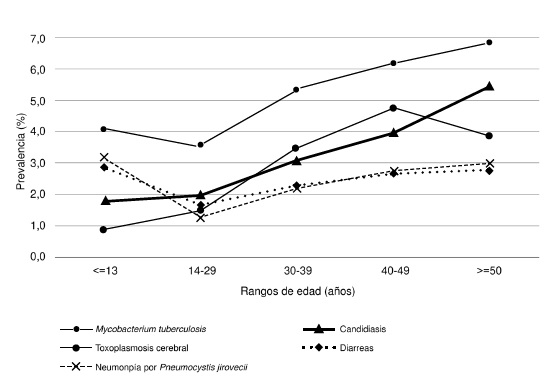Prevalence of opportunistic infections in insured patients with HIV and their association with socioeconomic and clinical factors in Colombia, 2012
Abstract
Introduction: Despite advances in treatment, opportunistic infections are the major cause of morbidity and mortality among patients with the human immunodeficiency virus (HIV).
Objectives: To estimate the prevalence of opportunistic infections among insured HIV patients, and to establish its association with socio-demographic and clinical factors.
Materials and methods: This was an observational study with an analytical focus. We analysed 37,325 records of insured people with HIV. A bivariate analysis using chi square and ANOVA, adjusted by Bonferroni, and multiple logistic regression for the adult population were carried out to explore the association among any opportunistic infections as the response variable and socio-demographic and clinical factors.
Results: From the total, at least 18% experienced an opportunistic infection. The most frequent were tuberculosis and brain toxoplasmosis for adults, and pneumonia and diarrhea for patients under 13 years of age. The prevalence of any opportunistic infection was significantly higher in men (OR=1.5; CI95% 1.4-1.6), in those more than 40 years of age (OR=1.6; CI95% 1.3-2.0), in people subjected to forced displacement (OR=1.7; CI95% 1.5-1.9), and in those belonging to the subsidized or exception health affiliation regimes (OR= 2.7; CI95% 2.1-3.4). Regarding clinical factors, opportunistic infections were significantly associated to time since diagnosis (>10 years) (OR=1.6; CI95% 1.5-1.7), administration of antiretroviral treatment (OR=4.4; CI95% 3.9-5.1), and discontinuity of treatment (OR=1.7; CI95% 1.6-1.8). The multivariate analysis for adults in clinical stage A showed similar results.
Conclusions: Despite the preventable nature of opportunistic infections, their prevalence is high and they predominantly affect the most disadvantaged people.
Downloads
Some similar items:
- Miriam Partida, Melva Gutiérrez, María de la Luz Ayala, Nelly Margarita Macías, Carlos Rogelio Alvizo, Jorge Peregrina, LEPR polymorphisms and haplotypes in Mexican patients with colorectal cancer , Biomedica: Vol. 39 No. 1 (2019)

| Article metrics | |
|---|---|
| Abstract views | |
| Galley vies | |
| PDF Views | |
| HTML views | |
| Other views | |

























